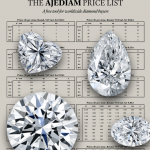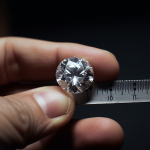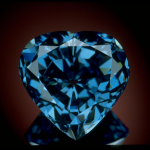Diamond Prices
Read moreLearn About Jewelry Gem Stones Pearls Precious Metals Settings
Learn online about jewelry, gems, pearls, precious metals and all types of settings for free
Ajediam gives you everything you need to learn about fine diamond jewelry.
Find out where to buy Lab-grown Synthetic diamonds, also named Man made, Cultured diamonds.
Know the real cost price of the producer. – Source: Antwerp World Diamond Centre.
We provide some facts and describe materials, settings used for jewelry
and methods to hold diamonds Diamond course online for free
Jewelry Guide: Read about jewelry cleaner
Ring size
To know your ring size measure the inside diameter of a ring that fits well. The size maybe between 4 and 13.5 millimeters.
Materials:
Buying jewelry : it may be comforting to know a little about the materials and techniques we jewelers use. In the following we hand you some information on gold and platinum, on colored gemstones and on manufacturing techniques. If you have questions remaining, send us a mail.Gold, platinum, silver are the materials most often used in jewelry. We prefer to use pure nickel-free platinum and gold 18K, 75% Pure Gold because of their long lasting quality and appearance.
Gold
Gold has been used since ancient times to create jewelry, art and religious articles. Its unique color, and the fact that it can be mixed with other metals, makes it one of the most popular metals for jewelry to this day.
Platinum
Platinum is an extremely durable metal. Since the 1880s it has been used to make fine jewelry. As it is both a dense and strong metal, platinum is favored over other metals to hold diamonds.
For complex designs, with an inlay of many small stones, jewelers prefer platinum over gold. As with gold, platinum is also mixed with other metals. Common marks are: 850 Plat, PT 850, PT 850. The alloy is also mentioned sometimes, like in 850 Plat, 150 Irid (Iridium).
Silver
We use plain silver 925 for fashion big jewelry because it is cheap.
Color Gem-stones
Rubies, sapphires, emeralds, aquamarines and topaz are famous examples of the very popular category of colored gemstones.
Gemstones are measured by their weight and size. The size of a gemstone is expressed in millimeters (for example, 6×8 millimeters). The basic unit for weighing gemstones is the carat, equal to 1/5nth of a gram.
Carats are divided into 100 units.These units are called points. For example, 1/10 gram of gemstone is equal to ½ carat, is equal to 50 points.
Other colored gemstones you may frequently encounter are Aquamarine, Quartz, Citrine, Tanzanite and Tourmaline & Citrine
As technology advances we see many product and process innovations in the area of gemstones. Synthetic gemstones, in a jewelry store sometimes abbreviated “CTRD” are an important example of such an innovation.
These stones posses the same optical, chemical and physical properties as natural gemstones. Although they are as beautiful as the real thing, they have been produced entirely in a laboratory. And, therefor, they should be much cheaper.
The same applies to composite or assembled stones, which consist of glass and synthetic parts held together by a color injected glue.
Natural color gemstones may have been processed as well. So as to enhance their color, they may have been dyied, irradiated, or treated with heat. While the color may have embellished, the durability possibly diminished.
Be sure to ask a jeweler what type of gemstone you have at hand, and what processes it endured before reaching his store or office. If not for the appearance, you at least want to pay the right price for the real value.
Pearls are another beautiful offspring of nature. They are made by oysters and other mollusks. When grown without the help of humans, we speak of Natural pearls. Specialist pearl divers search for these rare species, mostly in the tropical waters of the pacific.
The longer a pearl is left cultivating in the oyster, the thicker its “nacre skin. Pearls with a thin nacre do not last long. Natural chemicals and perfumes bite into the skin, worsening its appearance rapidly.
Cultured pearls have been grown by mollusks, in a protected & conditioned environment. They are not as rare
as the natural type, and cost less. Be sure to ask your jeweler how the pearls you prefer have been grown.
You may find out they are fake pearls, made from glass, organic materials or plastic.
Settings
Methods to hold diamonds.
The way jewelry is constructed has a strong effect on its beauty and durability. For long lasting jewelry the right amounts of solder should be used. The gold or platinum should be of adequate thickness. And, very important, the stone settings should be firm and neat.
Good and lesser techniques exist to keep gemstones and pearls in place. Some of the important ones are the pave setting, the channel setting and the prong setting.
Tiffany setting
Tiffany setting is a popular setting for solitaire diamond engagement rings with 4 or 6 prongs, depending of the importance of the diamond. Prong setting hold diamonds safely, enabling best amount of light to enter diamonds
Classic Tiffany setting style has captured the hearts of millions of couples searching for the perfect engagement ring for their loose diamond.
Channel setting
For a channel setting a jeweler makes a groove inside two strips of metal. This groove, with the metal strips on the sides, can hold a row of stones.
Prong Setting also named claw setting
The prong setting is used for faceted gemstones. Prongs are a type of metal claws, which hold the gemstone in place. Mostly four or more claws are used for setting one stone.
Bead Setting
The bead setting is also used for gemstones. A metal bead shaped strip surrounds the stone, and raises it from the surface of the jewelry piece.
Pave setting
The pave setting is used for diamonds and other jewelry which is supposed to have a long lifetime. The Pave setting requires patience and workmanship. It takes about a day for a skilled diamond setter to make one pave set diamond necklace.
Tiny holes are shaped by hand in the gold, to hold the stones safely. The exposed gold surfaces are textured into a bead finish, and their edges polished to shiny ribbons of gold.
Other popular settings:
Closter setting
Tension setting
Bezel setting
Send us an Email if you have any questions remaining. We will try to answer them to the best of our knowledge.




